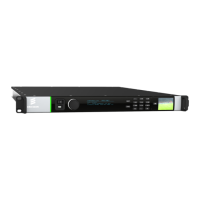Getting Started
HEVC HDTV and UHDTV 10-bit Recommendation
The 10 bit format can be used at the same bit rate as in 8 bit even at low bit rates.
There is no cross-over in video quality between 8 bit and 10 bit. Even at low bit
rates, the 10 bit format can remove contour artifacts on flat areas or on fade
changes.
Horizontal Bandwidth
Always set to 100% for Contribution and Distribution applications
Inloop Filter
The default (recommended) setting is Normal. Setting the Inloop Filter to Low can
be used to improve sharpness (e.g., in grass in sports sequences) at the expense of
increased blocking artifacts.
Auto mode is designed to be adaptive and alter the filter strength on a per-picture
basis, and will generally lower the filter strength on sports content to improve the
sharpness in grass, albeit at the expense of increased blocking artefacts on the
crowd and players perhaps, but will revert back to normal or higher filter strength on
other content.
3.10 How to Configure and Use Video Input Detection
Overview
The CE VCM’s are capable of detecting if there is a valid video stream available at
the SDI/HD-SDI input. The VCM can be set up to report whenever it detects a
format change in the input video stream, or it can even modify encoding parameters
to suit.
Note: Changes to the source that result in a change of configuration will result in a
loss of video for a short time. This outage time varies depending on the
configuration change.
Input Detection Configuration
Once a video component has been added to an output Transport Stream on the
Service Configuration page, input detection options can be set up on the Input
and Encode tabs for the respective video in the Properties widget.

